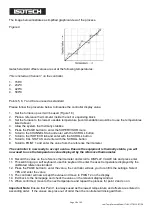
Page 29 of 43
Low Temp Furnace Model ITL-M-17701 13-07/20
REALISING THE FOLLOWING FIXED POINTS: INDIUM, LEAD, ZINC
These metals are characterised by a relatively short supercool (supercool is the characteristic of a freezing
pure metal to remain liquid at a temperature below that at which the solid melts). The supercool of these
metals can be expected to be less than 0.5°C.
The cell is placed in the furnace, suitable insulation and cover added and a monitoring thermometer
inserted. The furnace controller is set 5°C to 10°C above the expected melt temperature. The temperature
rise is monitored with a bridge and/or recorder connected to the thermometer.
Following the melt arrest, the temperature of the cell will rise to the controlled temperature. The metal in
the cell is now entirely in the liquid phase and may be maintained in this condition for any desired period of
time, for example, to accommodate to a calibration schedule.
To freeze, the furnace controller is set below the actual freeze temperature (for pure metals, melt and
freeze temperatures are theoretically identical). The suggested setting is 1°C below the freeze
temperature; this is, assuredly, below the bottom of the supercool. The furnace is allowed to cool to this
new setpoint temperature, taking typically 30 to 45 minutes to do so.
When the monitor indicates that the cell is at, or below, its freeze temperature, the monitor is removed to a
rack and replaced by a rod of quartz at ambient temperature. This initiates nucleation. After 2 minutes the
rod can be removed and replaced by the monitor again.
This procedure creates a radial freeze from the inside and outside walls of the cell towards the centre.
If the cell is left too long in the furnace without initiating the freeze as described above, nucleation will occur
and the cell will begin to freeze from the bottom of the cell upwards. This will result in a short, imperfect,
plateau and, moreover, give an incorrect value of freeze point (typically 10mK below that expected).
Depending upon factors such as furnace control and the number of thermometers successively loaded into
the cell, plateau durations between an hour and many hours may be achieved. Thermometers may be
preheated prior to transfer to the cell. A pocket is provided in the furnace for this purpose. It is wise to
ascertain from time to time that the plateau is still in existence, by checking the cell temperature with the
monitoring thermometer at intervals within the measurement sequence. Let us suppose that Th
m
is the
monitoring thermometer and Th
1
...
n
are thermometers to be calibrated. If n=2 a suitable sequence might be
Th
m
, Th
1
, Th
m
, Th
2
, Th
m
and if n=4
Th
m
, Th
1
, Th
2
, Th
m
, Th
3
, Th
4
, Th
m
The Th
m
measured last should be equal in indication to that of the Th
m
measured first to ensure that the
plateau has been present for Th
1
, etc.
At the temperatures of Indium, Lead and Zinc it is generally permissible to withdraw a thermometer, of type
Isotech 909, directly into room temperature.















































